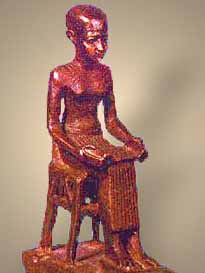
God of learning and medicine.
His name means 'The One Who Comes in Peace'.

God of learning and medicine.
His name means 'The One Who Comes in Peace'.
�Imhotep was a vizier, wizard, and the first architect and physician known by name to written history. As the story goes, he was the son of Ptah, his mother was sometimes said to be �Sekhmet, who was often said to be married to Ptah, since she was the patron of Upper Egypt.
Very little has survived about the details of his life, though numerous statues and statuettes of him have been found. Some show him as an ordinary man who is dressed in plain attire.
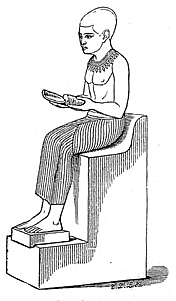
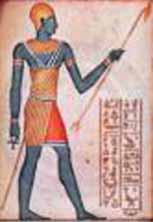
Later, his statuettes show him with a god like beard,
standing, and carrying the ankh and a scepter.Ê

Inscription with the names of Netjerikhet (Djoser) and Imhotep
Imhotep also served as chancellor to the pharaoh and high priest of the sun god Ra at Heliopolis. He was said to be a son of Ptah, his mother being a mortal named Khredu-ankh. He was revered as a genius and showered with titles.
The full list of titles is:
Chancellor of the King of Lower Egypt,
First after the King of Upper Egypt,
Administrator of the Great Palace,
Hereditary nobleman,
High Priest of Heliopolis, Builder,
Sculptor and Maker of Vases in Chief
As the �Pharaoh Djoser's Vizier, he designed the Step Pyramid at Saqqara in Egypt around 2630-2611 BC, during the Third Dynasty. The Step Pyramid Complex remains today one of the most brilliant architecture wonders of the ancient world and is recognized as the first monumental stone structure.
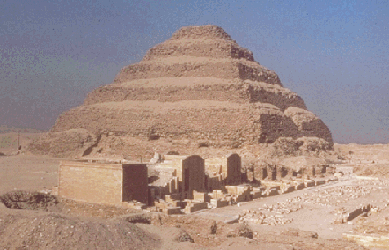
As a builder, Imhotep is the first master architects who we know by name. He may have had a hand in the building of Sekhemkhet's unfinished pyramid, and also possibly with the establishment of the Edfu Temple, but that is not certain.
James Henry Breasted says of Imhotep:
"In priestly wisdom, in magic, in the formulation of wise proverbs; in medicine and architecture; this remarkable figure of Zoser's reign left so notable a reputation that his name was never forgotten. He was the patron spirit of the later scribes, to whom they regularly poured out a libation from the water-jug of their writing outfit before beginning their work."
Imhotep is credited as the founder of Egyptian medicine, and as author of the Edwin Smith papyrus, in which more than 90 anatomical terms and 48 injuries are described. The Edwin Smith Papyrus was probably written around 1700 BC but may perhaps go back to texts written around 1000 years earlier.
He may have also founded a school of medicine in Memphis, a part of his cult center possibly known as "Asklepion, which remained famous for two thousand years. All of this occurred some 2,200 years before the 'Western Father of Medicine Hippocrates' was born.
Two thousand years after his death, his status was raised to that of a god. He was linked to Asclepius by the Greeks.
As he was thought of as the inventor of healing, he was also sometimes said to be the one who held Nuit (deification of the sky) up, as the separation of Nuit and Geb (deification of the earth) was said to be what held chaos back.
Due to the position this would have placed him in, he was also sometimes said to be Nuit's son. In artwork he is also linked with Hathor, who was the wife of Ra, -- Maat, which was the concept of truth and justice, and Amenhotep son of Hapu, who was another deified architect.
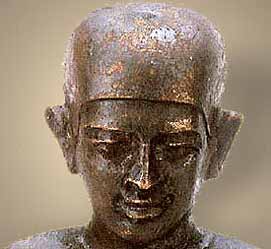
Imhotep is one example of the "personality cult" of Kemet, whereby a learned sage or otherwise especially venerated person could be deified after death and become a special intercessor for the living, much as the saints of Roman Catholicism.
About 100 years after his death, he was elevated as a medical demigod. In about 525, around 2,000 years after his death, he was elevated to a full god, and replaced Nefertum in the great triad at Memphis.
In the Turin Canon, he was known as the "son of Ptah".
Imhotep was, together with Amenhotep, the only mortal Egyptians that ever reached the position of full gods.
He was also associated with Thoth, the god of wisdom, writing and learning, and with the Ibises, which was also associated with Thoth.
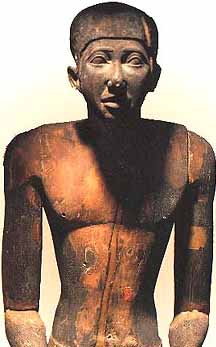
We are told that his main centers of worship were in the Ptolemaic temple to Hathor atf Dier el-Medina and at Karnak in Thebes, where he was worshipped in conjunction with Amenhotep-Son-of-Hapu, a sanctuary on the upper terrace of the temple at Deir el-Bahari, at Philae where a chapel of Imhotep stands immediately in front of the eastern pylon of the temple of Isis and of course, at Memphis in Lower (northern) Egypt, where a temple was erected to him near the Serapeum.
At Saqqara, we are told that people bought offerings to his cult center, including mummified Ibises and sometimes, clay models of diseased limbs and organs in the hope of being healed.
He was later even worshipped by the early Christians as one with Christ. The early Christians, it will be recalled, adapted to their use those pagan forms and persons whose influence through the ages had woven itself so powerfully into tradition that they could not omit them.
He was worshiped even in Greece where he was identified with their god of medicine, Aslepius.
He was honored by the Romans and the emperors Claudius and Tiberius had inscriptions praising Imhotep placed on the walls of their Egyptian temples.
He even managed to find a place in Arab traditions, especially at Saqqara where his tomb is thought to be located.Ê
Imhotep lived to a great age, apparently dying in the reign of King Huni, the last of the dynasty.
His burial place has not been found but it has been speculated that it may indeed be at Saqqara, possibly in an unattested mastaba 3518.